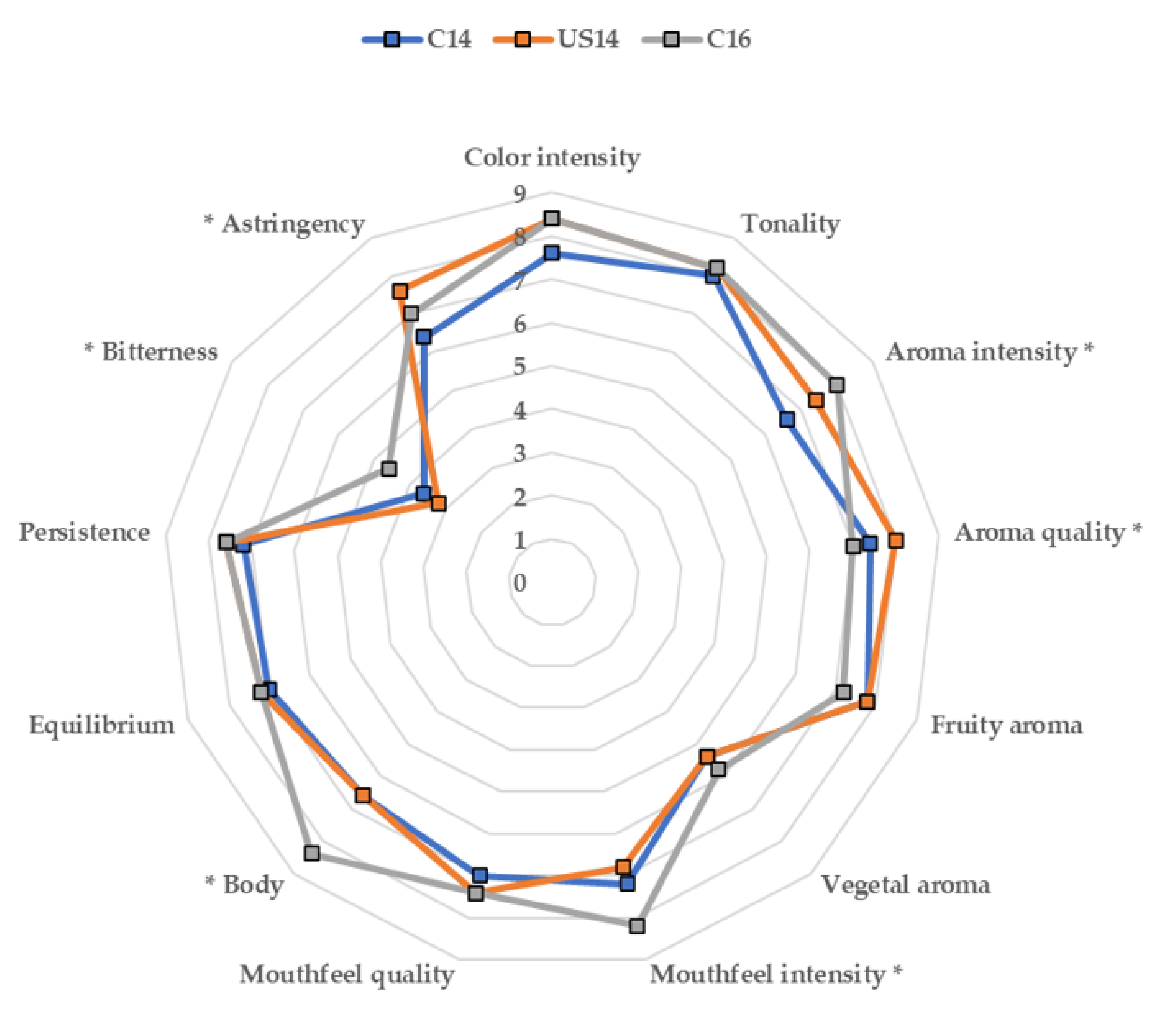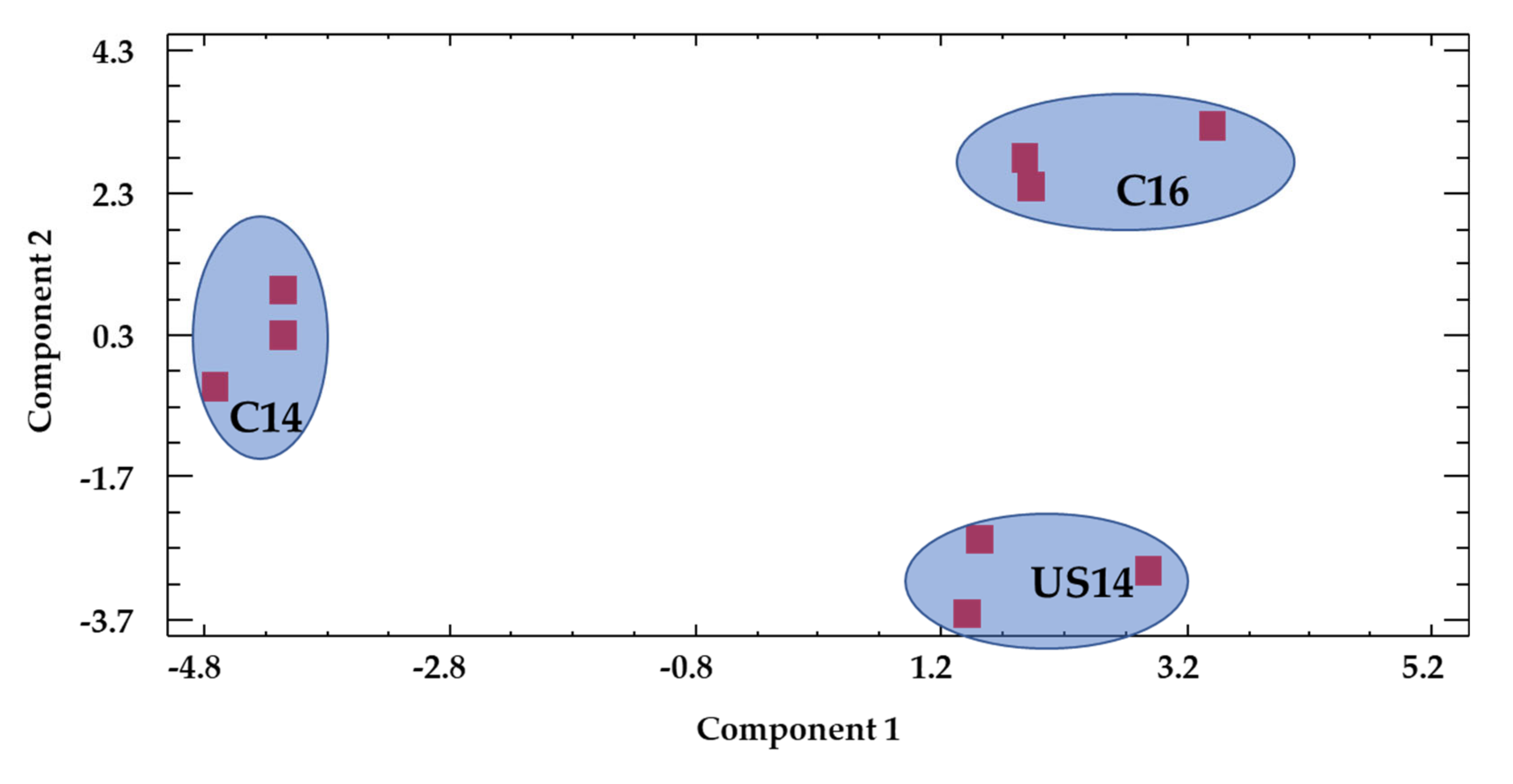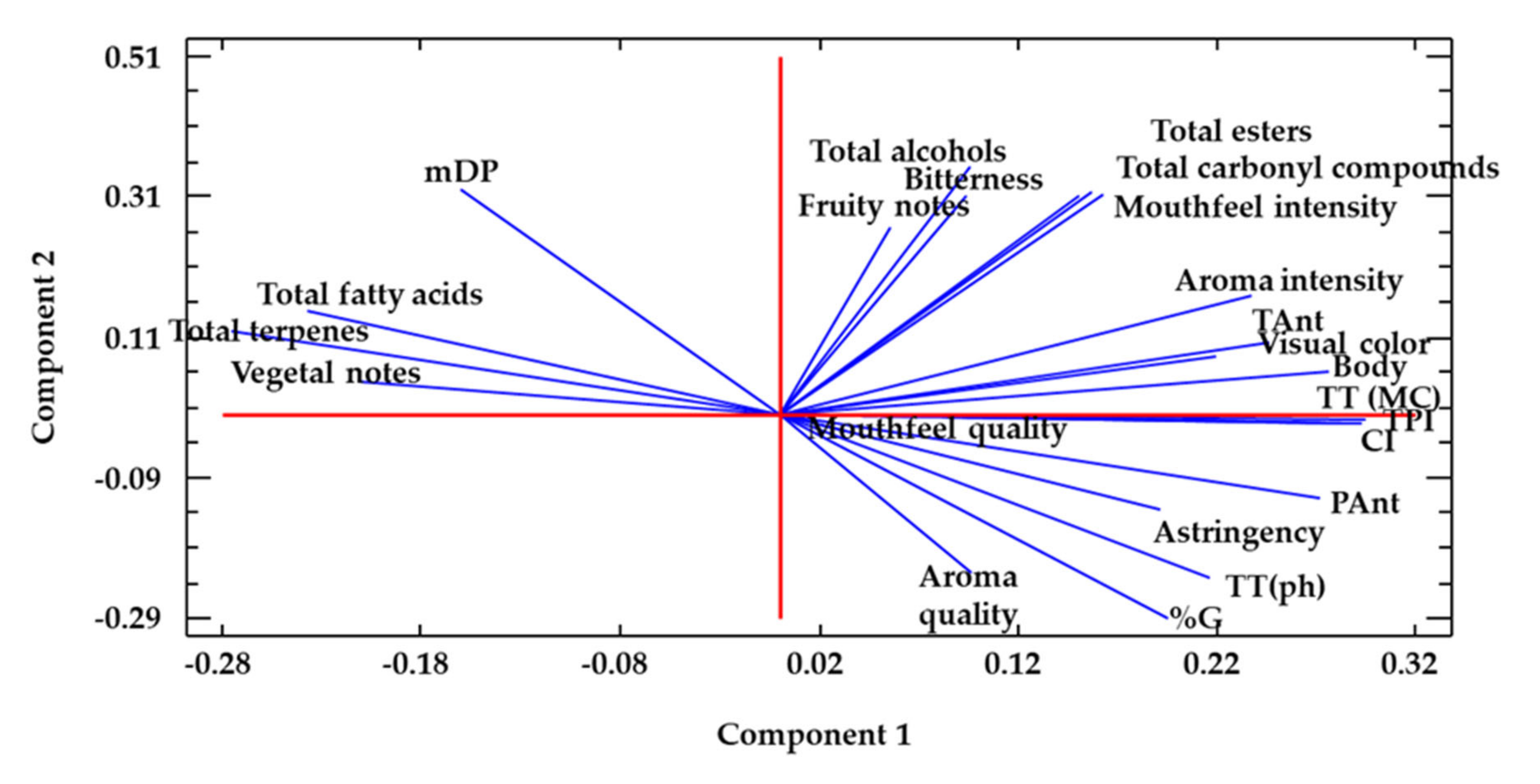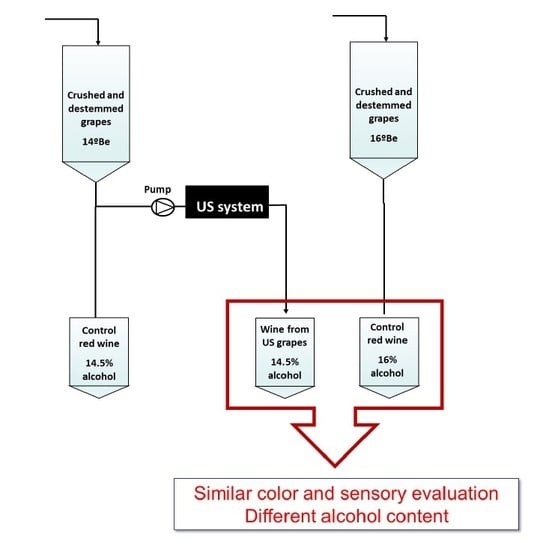A New Approach to the Reduction of Alcohol Content in Red Wines: The Use of High-Power Ultrasounds
Abstract
1. Introduction
- (a)
- (b)
- Reduce the use of SO2 by reducing microbial counts. In this way, Gracin et al. [29] found that high power ultrasounds applied in continuous flow showed satisfactory reduction of Brettanomyces yeasts (89.1–99.7%) and lactic acid bacteria (71.8–99.3%), and Santos et al. [30] review the possibility of using ultrasounds in several stages of winemaking for wine conservation;
- (c)
- Age wines on lees: Kulkarni et al. [31] used non-Saccharomyces strains coupled with ultrasound treatment to accelerate aging on lees, and studied their impacts on the polysaccharide release and on the organoleptic properties of red wine. Cacciola et al. [32] tested the effects of HPUs during wine aging on lees, and found that their effect could be compared with the use of β-glucanases, enzymes which are able to demolish the lees glucans and facilitate the release of intracellular components;
- (d)
- (e)
- Accelerate the reactions of aging: one other effect of cavitation is the production of highly reactive radical species, such as _OH and _H radicals, that may undergo a range of subsequent reactions, including the generation of H2O2, and these highly oxidizing species can have a significant effect on both biological and chemical species in aqueous solution [29]. The possible formation of free radicals could help accelerate wine aging reactions [37]. In this way, Zhang et al. [38] have provided the first direct evidence of the formation of the 1-hydroxylethyl free radical (a radical that arises from ethanol oxidation) in red wine exposed to ultrasounds. Lukic et al. [39] has stated that ultrasound treatment might accelerate some aging reactions and shorten the period of wine aging. Zhang and Wang [40] have stated that the ultrasound application did not only temporally influence the color characteristics and phenolic composition of wine, but it also has a longer effect on their evolution during wine storage.
2. Materials and Methods
2.1. Grapes
2.2. Winemaking (Micro-Vinification)
2.3. Analytical Determinations
2.4. Determination of Wine Volatile Compounds by Solid-Phase Microextraction–Gas Chromatography–Mass Spectrometry (SPME-GC-MS)
2.5. Sensory Analysis
2.6. Statistical Analysis
3. Results
4. Conclusions
Author Contributions
Funding
Conflicts of Interest
References
- Sacchi, K.L.; Bisson, L.F.; Adams, D.O. A review of the effect of winemaking techniques on phenolic extraction in red wines. Am. J. Enol. Vitic. 2005, 56, 197–206. [Google Scholar]
- Ortega-Regules, A.; Ros-García, J.M.; Bautista-Ortín, A.B.; López-Roca, J.M.; Gómez-Plaza, E. Changes in skin cell wall composition during the maturation of four premium wine grape varieties. J. Sci. Food Agric. 2008, 88, 420–428. [Google Scholar] [CrossRef]
- Saint-Cricq de Gaulejac, N.; Vivas, N.; Glories, Y. Maturité phénolique: Définition et contrôle. Rev. Fr. Oenol. 1998, 173, 22–25. [Google Scholar]
- Bautista-Ortín, A.B.; Rodríguez-Rodríguez, P.; Gil-Muñoz, R.; Jiménez-Pascual, E.; Busse-Valverde, N.; Martínez-Cutillas, A.; López-Roca, J.M.; Gómez-Plaza, E. Influence of berry ripeness on concentration, qualitative composition and extractability of grape seed tannins. Aust. J. Grape Wine Res. 2012, 18, 123–130. [Google Scholar] [CrossRef]
- Rousserie, P.; Lacampagne, S.; Vanbrabant, S.; Rabot, A.; Geny-Denis, L. Influence of berry ripeness on seed tannins extraction in wine. Food Chem. 2020, 315, 126307. [Google Scholar] [CrossRef]
- Mira De Orduña, R. Climate change associated effects on grape and wine quality and production. Food Res. Int. 2010, 43, 1844–1855. [Google Scholar] [CrossRef]
- Jones, G.V.; Davis, R.E. Climate influences on grapevine phenology, grape composition, and wine production and quality for Bordeaux, France. Am. J. Enol. Vitic. 2000, 51, 249–261. [Google Scholar]
- Longo, R.; Blackman, J.W.; Antalick, G.; Torley, P.J.; Rogiers, S.Y.; Schmidtke, L.M. Volatile and sensory profiling of Shiraz wine in response to alcohol management: Comparison of harvest timing versus technological approaches. Food Res. Int. 2018, 109, 561–571. [Google Scholar] [CrossRef]
- Jackson, R.S. Wine Science: Principles and Applications, 3rd ed.; Academic Press: San Diego, CA, USA, 2008; pp. 270–331. [Google Scholar]
- Henderson, C.M.; Block, D.E. Examining the role of membrane lipid composition in determining the ethanol tolerance of Saccharomyces cerevisiae. Appl. Environ. Microbiol. 2014, 80, 2966–2972. [Google Scholar] [CrossRef]
- Boulton, R.B.; Singleton, V.L.; Bisson, L.F.; Kunkee, R.E. Principles and Practices of Winemaking, 1st ed.; Chapman and Hall Publishers: New York, NY, USA, 1996. [Google Scholar]
- Wilkinson, K.; Jiranck, V. Wine of reduced alcohol content: Consumer and society demand vs industry willingness and ability to deliver. In Proceedings of the 1st International Symposium on Alcohol Level Reduction in Wine Oenoviti International Network, Bordeaux, France, 6 September 2013; Institut des Sciences de la Vigne et du Vin: Villenave d’Ornon, France, 2013; pp. 98–104. [Google Scholar]
- Goldner, C.; Zamora, M.C.; Lira, P.; Gianninoto, H.; Bandoni, A. Effect of ethanol level in the perception of aroma attributes and the detection of volatile compounds in red wine. J. Sens. Stud. 2009, 24, 243–257. [Google Scholar] [CrossRef]
- King, E.; Dunn, R.; Heymann, H. The influence of alcohol on the sensory perception of red wines. Food Qual. Prefer. 2013, 28, 235–243. [Google Scholar] [CrossRef]
- Gawel, R.; Sluyter, S.V.; Waters, E.J. The effects of ethanol and glycerol on the body and other sensory characteristics of Riesling wines. Aust. J. Grape Wine Res. 2007, 13, 38–45. [Google Scholar] [CrossRef]
- Sharma, A.; Vandenberg, B.; Hollingsworth, B. Minimum pricing of alcohol versus volumetric taxation: Which policy will reduce heavy consumption without adversely affecting light and moderate consumers? PLoS ONE 2014, 9, e80936. [Google Scholar] [CrossRef] [PubMed]
- Piccardo, D.; Favre, G.; Pascual, O.; Canals, J.M.; Zamora, F.; González-Neves, G. Influence of the use of unripe grapes to reduce ethanol content and pH on the color, polyphenol and polysaccharide composition of conventional and hot macerated Pinot Noir and Tannat wines. Eur. Food Res. Technol. 2019, 245, 1321–1335. [Google Scholar] [CrossRef]
- Teng, B.; Petrie, P.R.; Smith, P.A.; Bindon, K.A. Comparison of water addition and early-harvest strategies to decrease alcohol concentration in Vitis vinifera cv. Shiraz wine: Impact on wine phenolics, tannin composition and colour properties. Aust. J. Grape Wine Res. 2020, 26, 158–171. [Google Scholar] [CrossRef]
- Grazia, A.; Pietrafesa, A.; Capece, A.; Pietrafesa, R.; Siesto, G.; Romano, P. Exploitation of technological variability among wild non-Saccharomyces yeasts to select mixed starters for the production of low alcohol wines. BIO Web Conf. 2019, 15. [Google Scholar] [CrossRef]
- Varela, C.; Kutyna, D.R.; Solomon, M.R.; Black, C.A.; Borneman, A.; Henschke, P.A.; Pretorius, I.S.; Chambers, P.J. Evaluation of gene modification strategies for the development of low-alcohol-wine yeasts. Appl. Environ. Microbiol. 2012, 78, 6068–6077. [Google Scholar] [CrossRef]
- Corona, O.; Liguori, L.; Albanese, D.; Di Matteo, M.; Cinquanta, L.; Russo, P. Quality and volatile compounds in red wine at different degrees of dealcoholization by membrane process. Eur. Food Res. Technol. 2019, 245, 2601–2611. [Google Scholar] [CrossRef]
- Pham, D.T.; Stockdale, V.J.; Wollan, D.; Jeffery, D.W.; Wilkinson, K.L. Compositional consequences of partial dealcoholization of red wine by reverse osmosis-evaporative perstraction. Molecules 2019, 24, 1404. [Google Scholar] [CrossRef]
- Clodoveo, M.L.; Dipalmo, T.; Rizzello, C.G.; Corbo, F.; Crupi, P. Emerging technology to develop novel red winemaking practices: An overview. Innov. Food Sci. Emerg. Technol. 2016, 38, 41–56. [Google Scholar] [CrossRef]
- Luo, H.; Schmid, F.; Grbin, P.R.; Jiranek, V. Viability of common wine spoilage organisms after exposure to high power ultrasonics. Ultrason. Sonochem. 2012, 19, 415–420. [Google Scholar] [CrossRef] [PubMed]
- Gambacorta, G.; Trani, A.; Punzi, R.; Fasciano, C.; Leo, R.; Fracchiolla, G.; Faccia, M. Impact of ultrasounds on the extraction of polyphenols during winemaking of red grapes cultivars from southern Italy. Innov. Food Sci. Emerg. Technol. 2017, 43, 54–59. [Google Scholar] [CrossRef]
- El Darra, N.; Grimi, N.; Maroun, R.G.; Louka, N.; Vorobiev, E. Pulsed electric field, ultrasound, and thermal pretreatments for better phenolic extraction during red fermentation. Eur. Food Res. Technol. 2013, 236, 47–56. [Google Scholar] [CrossRef]
- Bautista-Ortín, A.B.; Jiménez-Martínez, M.D.; Jurado, R.; Iniesta, J.A.; Terrades, S.; Andrés, A.; Gómez-Plaza, E. Application of high-power ultrasounds during red wine vinification. Int. J. Food Sci. Technol. 2017, 52, 1314–1323. [Google Scholar] [CrossRef]
- Maza, M.; Álvarez, I.; Raso, J. Thermal and non-thermal physical methods for improving polyphenol extraction in red winemaking. Beverages 2019, 5, 47. [Google Scholar] [CrossRef]
- Gracin, L.; Jambrak, A.R.; Juretić, H.; Dobrović, S.; Barukčić, I.; Grozdanović, M.; Smoljanić, G. Influence of high power ultrasound on Brettanomyces and lactic acid bacteria in wine in continuous flow treatment. Appl. Acoust. 2016, 103, 143–147. [Google Scholar] [CrossRef]
- Santos, M.C.; Nunes, C.; Saraiva, J.A.; Coimbra, M.A. Chemical and physical methodologies for the replacement/reduction of sulfur dioxide use during winemaking: Review of their potentialities and limitations. Eur. Food Res. Technol. 2012, 234, 1–12. [Google Scholar] [CrossRef]
- Kulkarni, P.; Loira, I.; Morata, A.; Tesfaye, W.; Gonzalez, M.; Suárez-Lepe, J.A. Wine maturation: Use of ultrasound treatment and non-Saccharomyces yeasts for accelerating ageing on lees in red wines. Wine Vitic. J. 2016, 31, 36. [Google Scholar]
- Cacciola, V.; Batllò, I.F.; Ferraretto, P.; Vincenzi, S.; Celotti, E. Study of the ultrasound effects on yeast lees lysis in winemaking. Eur. Food Res. Technol. 2013, 236, 311–317. [Google Scholar] [CrossRef]
- González-Centeno, M.R.; Knoerzer, K.; Sabarez, H.; Simal, S.; Rosselló, C.; Femenia, A. Effect of acoustic frequency and power density on the aqueous ultrasonic-assisted extraction of grape pomace (Vitis vinifera L.). A response surface approach. Ultrason. Sonochem. 2014, 21, 2176–2184. [Google Scholar] [CrossRef]
- Tao, Y.; Zhang, Z.; Sun, D.W. Kinetic modeling of ultrasound-assisted extraction of phenolic compounds from grape marc: Influence of acoustic energy density and temperature. Ultrason. Sonochem. 2014, 21, 1461–1469. [Google Scholar] [CrossRef] [PubMed]
- Drosou, C.; Kyriakopoulou, K.; Bimpilas, A.; Tsimogiannis, D.; Krokida, M. A comparative study on different extraction techniques to recover red grape pomace polyphenols from vinification byproducts. Ind. Crops Prod. 2015, 75, 141–149. [Google Scholar] [CrossRef]
- Piñeiro, Z.; Marrufo-Curtido, A.; Serrano, M.J.; Palma, M. Ultrasound-assisted extraction of stilbenes from grape canes. Molecules 2016, 21, 784. [Google Scholar] [CrossRef] [PubMed]
- Martín, J.F.G.; Sun, D.W. Ultrasound and electric fields as novel techniques for assisting the wine ageing process: The state-of-the-art research. Trends Food Sci. Technol. 2013, 33, 40–53. [Google Scholar] [CrossRef]
- Zhang, Q.A.; Shen, Y.; Fan, X.H.; Martín, J.F.G.; Wang, X.; Song, Y. Free radical generation induced by ultrasound in red wine and model wine: An EPR spin-trapping study. Ultrason. Sonochem. 2015, 27, 96–101. [Google Scholar] [CrossRef] [PubMed]
- Lukic, K.; Brnčić, M.; Curko, N.; Tomašević, M.; Valinger, D.; Denoya, G.; Barba, J.; Ganić, K.; Zhang, Q.A.; Wang, T.T. Effects of high power ultrasound treatments on the phenolic, chromatic and aroma composition of young and aged red wine. Ultrason. Sonochem. 2019, 59, 104725. [Google Scholar] [CrossRef]
- Zhang, Q.A.; Wang, T.T. Effect of ultrasound irradiation on the evolution of color properties and major phenolic compounds in wine during storage. Food Chem. 2017, 234, 372–380. [Google Scholar] [CrossRef]
- Commission Regulation (EEC), No. 2676/90 determining Community methods for the analysis of wines. Off. J. Eur. Communities 1999, L272, 1–192. Available online: http://data.europa.eu/eli/reg/1990/2676/oj (accessed on 12 March 2020).
- Boulton, R. The copigmentation of anthocyanins and its role in the color of red wine: A critical review. Am. J. Enol. Vitic. 2001, 52, 67–87. [Google Scholar]
- Ribéreau-Gayon, P.; Dubourdieu, D.; Donèche, B.; Lonvaud, A. (Eds.) The Microbiology of Wine and Vinifications. In Handbook of Enology, 2nd ed.; John Wiley & Sons: West Sussex, UK, 2006. [Google Scholar]
- Smith, P.A. Precipitation of tannin with methyl cellulose allows tannin quantification in grape and wine samples. Technical Review. AWRI Adel. Aust. 2005, 158, 3–7. [Google Scholar]
- Busse-Valverde, N.; Gomez-Plaza, E.; Lopez-Roca, J.M.; Gil-Munoz, R.; Fernandez-Fernandez, J.I.; Bautista-Ortin, A.B. Effect of different enological practices on skin and seed proanthocyanidins in three varietal wines. J. Agric. Food Chem. 2010, 58, 11333–11339. [Google Scholar] [CrossRef]
- Pastor del Rio, J.L.; Kennedy, J.A. Development of proanthocyanidins in Vitis vinifera L. cv. Pinot noir grapes and extraction into wine. Am. J. Enol. Vitic. 2006, 57, 125–132. [Google Scholar]
- Gómez-Plaza, E.; Mestre-Ortuño, L.; Ruiz-García, Y.; Fernández-Fernández, J.I.; López-Roca, J.M. Effect of benzothiadiazole and methyl jasmonate on the volatile compound composition of Vitis vinifera L. Monastrell grapes and wines. Am. J. Enol. Vitic. 2012, 63, 394–401. [Google Scholar] [CrossRef]
- Cortell, J.M.; Halbleib, M.; Gallagher, A.V.; Righetti, T.L.; Kennedy, J.A. Influence of vine vigor on grape (Vitis vinifera L. cv. Pinot Noir) anthocyanins. 1. Anthocyanin concentration and composition in fruit. J. Agric. Food Chem. 2007, 55, 6575–6584. [Google Scholar] [CrossRef] [PubMed]
- Hodson, G.; Wilkes, E.; Azevedo, S.; Battaglene, T. Methanol in wine. BIO Web Conf. 2017, 9, 02028. [Google Scholar] [CrossRef]
- Zhang, Q.A.; Shen, Y.; Fan, X.H.; García Martín, J.F. Preliminary study of the effect of ultrasound on physicochemical properties of red wine. CyTA J. Food. 2016, 14, 55–64. [Google Scholar] [CrossRef]
- Peinado, R.A.; Moreno, J.J.; Maestre, O.; Ortega, J.M.; Medina, M.; Mauricio, J.C. Gluconic acid consumption in wines by Schizosaccharomyces pombe and its effect on the concentrations of major volatile compounds and polyols. J. Agric. Food Chem. 2004, 52, 493–497. [Google Scholar] [CrossRef]
- Aleixandre-Tudo, J.L.; Lizama, V.; Alvarez, I.; Nieuwoudt, H.; García, M.J.; Aleixandre, J.L.; du Toit, W.J. Effect of acetaldehyde addition on the phenolic substances and volatile compounds of red Tempranillo wines. Aust. J. Grape Wine Res. 2015, 22, 205–214. [Google Scholar] [CrossRef]
- Del Torno-de Román, L.; Alonso-Lomillo, M.A.; Domínguez-Renedo, O.; Arcos-Martínez, M.J. Gluconic acid determination in wine by electrochemical biosensing. Sens. Actuators B Chem. 2013, 176, 858–862. [Google Scholar] [CrossRef]
- Picariello, L.; Gambuti, A.; Picariello, B.; Moio, L. Evolution of pigments, tannins and acetaldehyde during forced oxidation of red wine: Effect of tannins addition. LWT Food Sci. Technol. 2017, 77, 370–375. [Google Scholar] [CrossRef]
- Bautista-Ortín, A.B.; Fernández-Fernández, J.I.; López-Roca, J.M.; Gómez-Plaza, E. The effect of grape ripening stage on red wine color. OENO One 2006, 40, 15–24. [Google Scholar] [CrossRef]
- Pérez-Magariño, S.; González-San José, M.L. Polyphenols and colour variability of red wines made from grapes harvested at different ripeness grade. Food Chem. 2006, 96, 197–208. [Google Scholar] [CrossRef]
- Ferraretto, P.; Celotti, E. Preliminary study of the effects of ultrasound on red wine polyphenols. CyTA J. Food. 2016, 14, 529–535. [Google Scholar] [CrossRef]
- Roman, T.; Tonidandel, L.; Nicolini, G.; Bellantuono, E.; Barp, L.; Larcher, R.; Celotti, E. Evidence of the possible interaction between ultrasound and thiol precursors. Foods 2020, 9, 104. [Google Scholar] [CrossRef] [PubMed]
- Zhang, Q.A.; Xu, B.W.; Chen, B.Y.; Zhao, W.Q.; Xue, C.H. Ultrasound as an effective technique to reduce higher alcohols of wines and its influencing mechanism investigation by employing a model wine. Ultrason. Sonochem. 2020, 61, 104813. [Google Scholar] [CrossRef] [PubMed]
- Zhao, T.; Wu, J.; Meng, J.; Shi, P.; Fang, Y.; Zhang, Z.; Sun, X. Harvesting at the Right Time: Maturity and its Effects on the Aromatic Characteristics of Cabernet Sauvignon Wine. Molecules 2019, 24, 2777. [Google Scholar] [CrossRef]
- Dunlevy, J.D.; Kalua, C.M.; Keyzers, R.A.; Boss, P.K. The production of flavour & aroma compounds in grape berries. In Grapevine Molecular Physiology & Biotechnology, 3rd ed.; Markus Keller, Ed.; Springer: Dordrecht, The Netherlands, 2009; pp. 293–340. [Google Scholar] [CrossRef]
- Morena Luna, L.H.; Reynolds, A.G.; Di Profio, F.A.; Zhang, L.; Kotsaki, E. Crop level and harvest date impact on four Ontario wine grape cultivars. II. Wine aroma compounds and sensory analysis. S. Afr. J. Enol. Vitic. 2018, 39, 246–270. [Google Scholar] [CrossRef]
- Bindon, K.; Varela, C.; Kennedy, J.; Holt, H.; Herderich, M. Relationships between harvest time and wine composition in Vitis vinifera L. cv. Cabernet Sauvignon 1. Grape and wine chemistry. Food Chem. 2013, 138, 1696–1705. [Google Scholar] [CrossRef]
- Bakker, J.; Clarke, R.J. Wine: Flavour Chemistry, 2nd ed.; John Wiley & Sons: Hoboken, NJ, USA, 2011. [Google Scholar]
- Escudero, A.; Arias, I.; Lacau, B.; Astraín, J.; Barón, C.; Fernandez-Zurbano, P.; Ferreira, V. Effects of vineyard ‘potential’ and grape maturation on the aroma-volatile profile of Grenache wines. OENO One 2019, 53. [Google Scholar] [CrossRef]
- Restrepo, S.; Espinoza, L.; Ceballos, A.; Urtubia, A. Production of Fatty Acid Content during Alcoholic Wine Fermentation under Selected Temperature and Aeration Conditions. Am. J. Enol. Vitic. 2019, 70, 169–176. [Google Scholar] [CrossRef]
- Peng, C.T.; Wen, Y.; Tao, Y.S.; Lan, Y.Y. Modulating the formation of Meili wine aroma by prefermentative freezing process. J. Agric. Food Chem. 2013, 61, 1542–1553. [Google Scholar] [CrossRef] [PubMed]
- Ćurko, N.; Kelšin, K.; Jambrak, A.; Tomašević, M.; Gracin, L.; Poturica, V.; Ružman, E.; Ganić, K. The effect of high power ultrasound on phenolic composition, chromatic characteristics, and aroma compounds of red wines. Croat. J. Food Sci. Technol. 2017, 9, 136–144. [Google Scholar]
- García, J.F.; Zhang, Q.; Feng, C. Ultrasounds for accelerating the wine ageing process from physicochemical point of view. In Applications of Ultrasound in the Beverage Industry; Nova Sciences: Hauppauge, NY, USA; New York, NY, USA, 2016; pp. 147–165. [Google Scholar]
- Noble, A. Bitterness in wine. Physiol. Behav. 1994, 56, 1251–1255. [Google Scholar] [CrossRef]
- Cretin, B.; Dubourdieau, D.; Marchal, A. Influence of ethanol content on sweetness and bitterness perception in dry wines. LWT 2018, 87, 61–66. [Google Scholar] [CrossRef]
- Casassa, L.F.; Beaver, C.W.; Mireles, M.; Larsen, R.C.; Hopfer, H.; Heymann, H.; Harbertson, J.F. Influence of fruit maturity, maceration length, and ethanol amount on chemical and sensory properties of Merlot wines. Am. J. Enol. Vitic. 2013, 64, 437–449. [Google Scholar] [CrossRef]



| %Alc | RS | TS | pH | Tac | Vac | MeOH | Mal | Tart | Ethanal | Gluc | |
|---|---|---|---|---|---|---|---|---|---|---|---|
| C14 | 14.7 ± 0.2a | 1.8 ± 0.1a | 2.4 ± 0.1a | 3.7 ± 0.02b | 5.0 ± 0.1a | 0.6 ± 0.01a | 192.7 ± 2.5a | 0.8 ± 0.1b | 1.4 ± 0.1a | 55.3 ± 3.1a | 0.09 ± 0.01a |
| US14 | 14.6 ± 0.46a | 2.1 ± 0.1a | 2.6 ± 0.1a | 3.7 ± 0.01b | 5.1 ± 0.10a | 0.6 ± 0.01a | 261.0 ± 9.5c | 0.8 ± 0.1b | 1.5 ± 0.1a | 55.3 ± 9.0a | 0.10 ± 0.01a |
| C16 | 16.217 ± 0.1b | 3.4 ± 0.1b | 4.1 ± 0.b | 3.6 ± 0.01a | 5.7 ± 0.1b | 0.9 ± 0.01b | 217.7 ± 9.7b | 0.5 ± 0.1a | 1.4 ± 0.1a | 52.7 ± 3.5a | 0.34 ± 0.04b |
| Sample | CI | Hue | TPI | TAnt | PolAnt | TT (MC) |
|---|---|---|---|---|---|---|
| C14 | 14.34 ± 0.49a | 0.54 ± 0.01b | 47.95 ± 1.12a | 407.63 ± 17.70a | 73.07 ± 5.18a | 1444.13 ± 35.36a |
| US14 | 17.84 ± 1.22b | 0.56 ± 0.01c | 60.46 ± 3.56b | 453.23 ± 39.42ab | 98.95 ± 5.13b | 1930.31 ± 27.42b |
| C16 | 17.97 ± 0.79b | 0.53 ± 0.01a | 60.57 ± 1.56b | 475.49 ± 19.65b | 92.67 ± 3.83b | 1972.49 ± 47.60b |
| TT (mg/L) | mDP | %Gal | EGC (µM) | ECG (µM) | |
|---|---|---|---|---|---|
| C14 | 698.22 ± 21.14a | 6.21 ± 0.02c | 2.74 ± 0.01a | 398.11 ± 27.84a | 62.22 ± 11.45a |
| US14 | 951.47 ± 46.98c | 4.91 ± 0.07a | 4.16 ± 0.01c | 394.25 ± 31.66a | 129.71 ± 17.82b |
| C16 | 801.44 ± 17.12b | 6.03 ± 0.11b | 3.12 ± 0.02b | 451.39 ± 25.51a | 71.36 ± 9.53a |
| Control 14 | US14 | Control 16 | |
|---|---|---|---|
| Esters | |||
| 2-Methylpropyl acetate | 1290a | 1246a | 2140b |
| Ethyl butanoate | 7a | 9a | 15b |
| Ethyl 2-methylbutanoate | 10b | 2a | 3b |
| Ethyl 3-methylbutanoate | 4b | 2a | 4b |
| 3-Methylbutanol acetate | 316a | 252a | 377b |
| Ethyl hydrogen succinate | 2a | 3a | 5a |
| Ethyl hexanoate | 440a | 432a | 392a |
| Hexyl acetate | 89b | 8a | 4a |
| 3-Hexenyl acetate | 0a | 1b | 0a |
| Ethyl heptanoate | 10a | 13a | 28b |
| Ethyl 2-hexenoate | 15a | 13a | 12a |
| Methyl octanoate | 10a | 13a | 11a |
| Ethyl octanoate | 1760a | 1672a | 2049b |
| Isopentyl hexanoate | 17a | 23b | 31c |
| Ethyl decanoate | 1012a | 1343b | 1422b |
| 3-Methylbutanol octanoate | 36a | 38a | 46a |
| Diethyl succinate | 36a | 32a | 44b |
| Ethyl 9-decenoate | 30b | 14a | 19a |
| Ethyl undecanoate | 25b | 13a | 20b |
| 2-Phenylethyl acetate | 115b | 80a | 118b |
| Ethyl dodecanoate | 144a | 251b | 244b |
| Pentyl decanoate | 25a | 28a | 32a |
| Sum esters | 5445a | 54657a | 7184b |
| Alcohols | |||
| Propanol | 0a | 2b | 2b |
| 2-Methylpropanol | 146b | 115a | 161b |
| Butanol | 1a | 4b | 8c |
| 3-Methylbutanol | 2181a | 2048a | 3066b |
| 4-Methylpentanol | 1a | 1a | 3b |
| 3-Methylpentanol | 4a | 3a | 6b |
| Hexanol | 95b | 119c | 75a |
| Heptanol | 22c | 82a | 13b |
| 2-Ethylhexanol | 8a | 27c | 13b |
| Octanol | 15a | 17a | 21b |
| 2,3-Butanediol | 26a | 22a | 42.22b |
| Methyl thiopropanol | 18a | 12a | 2a |
| Benzyl alcohol | 26b | 0a | 0a |
| 2-Phenylethanol | 1849b | 1457a | 2324c |
| Sum alcohols | 4393a | 3836a | 5734b |
| Carbonyl compounds and lactones | |||
| 2-Octanone | 8a | 11b | 8a |
| Benzaldehyde | 13a | 16a | 20b |
| 3-Hydroxy-2-butanone | 84a | 82a | 169b |
| γ-Butyrolactone | 6b | 0a | 12c |
| Sum ketones | 111a | 110a | 209b |
| Acids | |||
| Acetic acid | 106a | 81a | 164b |
| Propanoic acid | 7b | 14b | 0a |
| Butanoic acid | 34a | 10a | 30a |
| Hexanoic acid | 73b | 27a | 21a |
| Octanoic acid | 161b | 72a | 43a |
| Sum acids | 380b | 205a | 258a |
| Terpens and norisoprenoids | |||
| Limonene | 6a | 4a | 4a |
| Terpinolene | 9a | 6a | 3a |
| (+)-cis-m-Menth-8-en | 18b | 14b | 0a |
| β-Ionone | 65b | 12a | 20a |
| Linalool | 17a | 16a | 40b |
| Terpinen-4-ol | 3b | 0a | 0a |
| Citronellol | 71b | 27a | 17a |
| Sum | 189b | 80a | 83a |
© 2020 by the authors. Licensee MDPI, Basel, Switzerland. This article is an open access article distributed under the terms and conditions of the Creative Commons Attribution (CC BY) license (http://creativecommons.org/licenses/by/4.0/).
Share and Cite
Martínez-Pérez, M.P.; Bautista-Ortín, A.B.; Pérez-Porras, P.; Jurado, R.; Gómez-Plaza, E. A New Approach to the Reduction of Alcohol Content in Red Wines: The Use of High-Power Ultrasounds. Foods 2020, 9, 726. https://doi.org/10.3390/foods9060726
Martínez-Pérez MP, Bautista-Ortín AB, Pérez-Porras P, Jurado R, Gómez-Plaza E. A New Approach to the Reduction of Alcohol Content in Red Wines: The Use of High-Power Ultrasounds. Foods. 2020; 9(6):726. https://doi.org/10.3390/foods9060726
Chicago/Turabian StyleMartínez-Pérez, María Pilar, Ana Belén Bautista-Ortín, Paula Pérez-Porras, Ricardo Jurado, and Encarna Gómez-Plaza. 2020. "A New Approach to the Reduction of Alcohol Content in Red Wines: The Use of High-Power Ultrasounds" Foods 9, no. 6: 726. https://doi.org/10.3390/foods9060726
APA StyleMartínez-Pérez, M. P., Bautista-Ortín, A. B., Pérez-Porras, P., Jurado, R., & Gómez-Plaza, E. (2020). A New Approach to the Reduction of Alcohol Content in Red Wines: The Use of High-Power Ultrasounds. Foods, 9(6), 726. https://doi.org/10.3390/foods9060726







